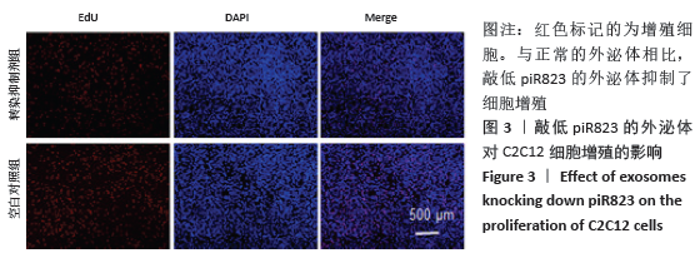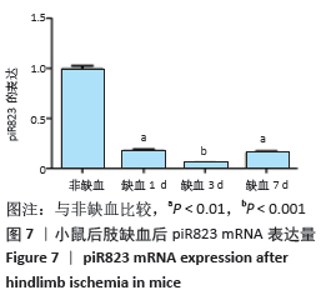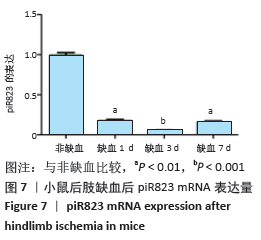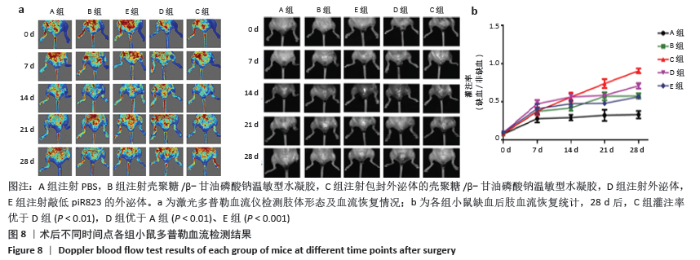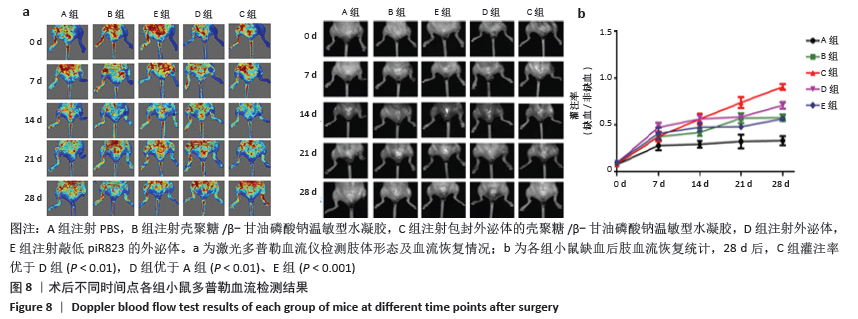Chinese Journal of Tissue Engineering Research ›› 2021, Vol. 25 ›› Issue (16): 2479-2487.doi: 10.3969/j.issn.2095-4344.3130
Previous Articles Next Articles
Application of temperature-sensitive chitosan hydrogel encapsulated exosomes in ischemic diseases
Liu Feng1, 2, Zhang Yu1, 2, Wang Yanli1, 2, Luo Wei1, 2, Han Chaoshan1, 2, Li Yangxin1, 2
- 1Institute of Cardiovascular Diseases, Medical College of Soochow University, Suzhou 215000, Jiangsu Province, China; 2Department of Cardiovascular Surgery, First Affiliated Hospital of Soochow University, Suzhou 215006, Jiangsu Province, China
-
Received:2020-07-15Revised:2020-07-17Accepted:2020-08-11Online:2021-06-08Published:2021-01-07 -
Contact:Li Yangxin, PhD, Professor, Institute of Cardiovascular Diseases, Medical College of Soochow University, Suzhou 215000, Jiangsu Province, China; Department of Cardiovascular Surgery, First Affiliated Hospital of Soochow University, Suzhou 215006, Jiangsu Province, China -
About author:Liu Feng, Master candidate, Institute of Cardiovascular Diseases, Medical College of Soochow University, Suzhou 215000, Jiangsu Province, China; Department of Cardiovascular Surgery, First Affiliated Hospital of Soochow University, Suzhou 215006, Jiangsu Province, China -
Supported by:Major Research Project of National Natural Science Foundation of China, No. 91849122 (to LYX); National Natural Science Foundation of China, 81870194 (to LYX); Jiangsu “Six Talents Peak” Innovation Team Project, No. BU 24600117 (to LYX)
CLC Number:
Cite this article
Liu Feng, Zhang Yu, Wang Yanli, Luo Wei, Han Chaoshan, Li Yangxin. Application of temperature-sensitive chitosan hydrogel encapsulated exosomes in ischemic diseases[J]. Chinese Journal of Tissue Engineering Research, 2021, 25(16): 2479-2487.
share this article

2.5 外泌体对壳聚糖/β-甘油磷酸钠温敏型水凝胶的影响 4 ℃下,壳聚糖/β-甘油磷酸钠温敏型水凝胶呈现为无色透明的液体,流动性好,pH值为6.8-7.2,并且在室温条件下可长时间保持液态。37 ℃下,短时间内发生交联反应,变为固态胶冻样凝胶,见图5A。将壳聚糖/β-甘油磷酸钠温敏型水凝胶通过皮下注入小鼠体内,15 min后剪开小鼠皮肤发现产生胶冻样物质,证明可在小鼠体内成胶,见图5B。为了探究外泌体对温敏型水凝胶成胶的影响,通过直观观察及用酶标仪进行吸光度值检测,发现在3个不同波长下壳聚糖溶液的吸光度值最低,加入外泌体后吸光度均增加,待温敏型水凝胶形成后吸光度值均进一步增加,见图5C,D。 "

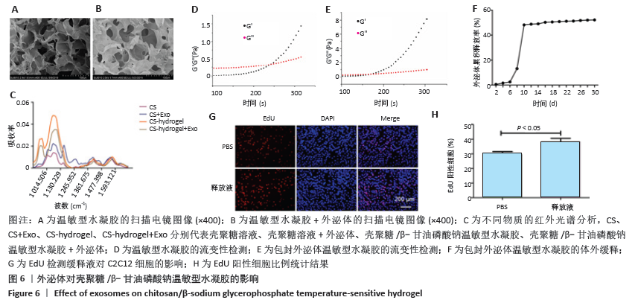
扫描电镜显示,壳聚糖/β-甘油磷酸钠温敏型水凝胶的直径为50-100 μm,加入外泌体后直径略微增大,见图6A,B。 傅里叶红外光谱检测结果显示,壳聚糖/β-甘油磷酸钠水凝胶原本位于1 567.33 cm-1的吸收峰,在加入外泌体后蓝移至1 573.64 cm-1处,见图6C。外泌体加入后并未引起显著变化,原因可能是外泌体与材料的基团发生作用降低了氢键作用,从而引起波数的轻微变化,进一步说明外泌体并未对温敏型水凝胶产生很大的影响,为温敏型水凝胶包封外泌体提供了基础。 流变学检测结果表明,壳聚糖/β-甘油磷酸钠温敏型水凝胶中的储存模量大于损耗模量,且加入外泌体后储存模量仍然大于损耗模量,同时缩短了温敏型水凝胶的成胶时间,见图6D,E。这说明加入外泌体后可以促进壳聚糖/β-甘油磷酸钠温敏型水凝胶的成胶,这也与傅里叶红外光谱的结果相一致。 因为壳聚糖/β-甘油磷酸钠温敏型水凝胶形成的孔径为50-120 μm,外泌体直径在30-100 nm,所以理论上外泌体的释放应快于水凝胶的降解速率。通过流式细胞仪检测不同时间收集的外泌体的量,计算外泌体累积的释放比例,结果表明PKH26标记的外泌体在第2天开始释放,在6-10 d快速释放,并达到最大释放量,见图6F。 将收集到的滤液与C2C12细胞共孵育,24 h后通过EdU试剂检测空白对照PBS及缓释液对细胞的影响,结果显示相较于PBS对照组,缓释液组EdU阳性细胞数量显著增加(P < 0.05),见图6G,H,表明外泌体可以从壳聚糖/β-甘油磷酸钠温敏型水凝胶缓释,并促进细胞增殖。 "

| [1] CONTE SM, VALE PR. Peripheral Arterial Disease. Heart Lung Circ. 2018; 27(4):427-432. [2] IWASE T, NAGAYA N, FUJII T, et al. Comparison of angiogenic potency between mesenchymal stem cells and mononuclear cells in a rat model of hindlimb ischemia. Cardiovasc Res. 2005;66(3):543-551. [3] OSTERBERG K, FALKENBERG M, RESCH T. Endovascular technique for arterial shunting to prevent intraoperative ischemia. Eur J Vasc Endovasc Surg. 2014;48(2):126-130. [4] SANTISTEVAN JR. Acute Limb Ischemia: An Emergency Medicine Approach. Emerg Med Clin North Am. 2017;35(4):889-909. [5] LI M, ZHOU H, JIN X, et al. Autologous bone marrow mononuclear cells transplant in patients with critical leg ischemia: preliminary clinical results. Exp Clin Transplant. 2013;11(5):435-439. [6] EGOROVA NN, GUILLERME S, GELIJNS A, et al. An analysis of the outcomes of a decade of experience with lower extremity revascularization including limb salvage, lengths of stay, and safety. J Vasc Surg. 2010;51(4):878-885, 885 e871. [7] KRAMANN R, GOETTSCH C, WONGBOONSIN J, et al. Adventitial MSC-like Cells Are Progenitors of Vascular Smooth Muscle Cells and Drive Vascular Calcification in Chronic Kidney Disease. Cell Stem Cell. 2016; 19(5):628-642. [8] MAZINI L, ROCHETTE L, ADMOU B, et al. Hopes and Limits of Adipose-Derived Stem Cells (ADSCs) and Mesenchymal Stem Cells (MSCs) in Wound Healing. Int J Mol Sci. 2020;21(4):1306. [9] DING Y, JOHNSON R, SHARMA S, et al. Tethering transforming growth factor beta1 to soft hydrogels guides vascular smooth muscle commitment from human mesenchymal stem cells. Acta Biomater. 2020;105:68-77. [10] HAN L, ZHOU Y, ZHANG R, et al. MicroRNA Let-7f-5p Promotes Bone Marrow Mesenchymal Stem Cells Survival by Targeting Caspase-3 in Alzheimer Disease Model. Front Neurosci. 2018;12:333. [11] BOON RA, DIMMELER S. MicroRNAs in myocardial infarction. Nat Rev Cardiol. 2015;12(3):135-142. [12] POLLER W, DIMMELER S, HEYMANS S, et al. Non-coding RNAs in cardiovascular diseases: diagnostic and therapeutic perspectives. Eur Heart J. 2018;39(29):2704-2716. [13] POOLE A. Collagen synthesis in rats with silica-induced pulmonary fibrosis. Arch Toxicol Suppl. 1987;11:285-287. [14] FENG Y, HUANG W, WANI M, et al. Ischemic preconditioning potentiates the protective effect of stem cells through secretion of exosomes by targeting Mecp2 via miR-22. PLoS One. 2014;9(2):e88685. [15] ZHANG HC, LIU XB, HUANG S, et al. Microvesicles derived from human umbilical cord mesenchymal stem cells stimulated by hypoxia promote angiogenesis both in vitro and in vivo. Stem Cells Dev. 2012;21(18): 3289-3297. [16] IMAI T, TAKAHASHI Y, NISHIKAWA M, et al. Macrophage-dependent clearance of systemically administered B16BL6-derived exosomes from the blood circulation in mice. J Extracell Vesicles. 2015;4:26238. [17] FENG J, WU Y, CHEN W, et al. Sustained release of bioactive IGF-1 from a silk fibroin microsphere-based injectable alginate hydrogel for the treatment of myocardial infarction. J Mater Chem B. 2020;8(2): 308-315. [18] ZHANG K, ZHAO X, CHEN X, et al. Enhanced Therapeutic Effects of Mesenchymal Stem Cell-Derived Exosomes with an Injectable Hydrogel for Hindlimb Ischemia Treatment. ACS Appl Mater Interfaces. 2018; 10(36):30081-30091. [19] VENKEI ZG, CHOI CP, FENG S, et al. A kinesin Klp10A mediates cell cycle-dependent shuttling of Piwi between nucleus and nuage. PLoS Genet. 2020;16(3):e1008648. [20] ZUO Y, ZOU Q, LIN J, et al. 2lpiRNApred: a two-layered integrated algorithm for identifying piRNAs and their functions based on LFE-GM feature selection. RNA Biol. 2020;17(6):892-902. [21] ZHANG W, YAO G, WANG J, et al. ncRPheno: a comprehensive database platform for identification and validation of disease related noncoding RNAs. RNA Biol. 2020;17(7):943-955. [22] PARHAD SS, YU T, ZHANG G, et al. Adaptive Evolution Targets a piRNA Precursor Transcription Network. Cell Rep. 2020;30(8):2672-2685 e5. [23] YAN H, WU QL, SUN CY, et al. piRNA-823 contributes to tumorigenesis by regulating de novo DNA methylation and angiogenesis in multiple myeloma. Leukemia. 2015;29(1):196-206. [24] YANG J, XUE FT, LI YY, et al. Exosomal piRNA sequencing reveals differences between heart failure and healthy patients. Eur Rev Med Pharmacol Sci. 2018;22(22):7952-7961. [25] WEICK EM, MISKA EA. piRNAs: from biogenesis to function. Development. 2014;141(18):3458-3471. [26] SARKAR A, VOLFF JN, VAURY C. piRNAs and their diverse roles: a transposable element-driven tactic for gene regulation? FASEB J. 2017; 31(2):436-446. [27] ILIEV R, FEDORKO M, MACHACKOVA T, et al. Expression Levels of PIWI-interacting RNA, piR-823, Are Deregulated in Tumor Tissue, Blood Serum and Urine of Patients with Renal Cell Carcinoma. Anticancer Res. 2016;36(12):6419-6423. [28] TANG X, XIE X, WANG X, et al. The Combination of piR-823 and Eukaryotic Initiation Factor 3 B (EIF3B) Activates Hepatic Stellate Cells via Upregulating TGF-beta1 in Liver Fibrogenesis. Med Sci Monit. 2018; 24:9151-9165. [29] YIN J, JIANG XY, QI W, et al. piR-823 contributes to colorectal tumorigenesis by enhancing the transcriptional activity of HSF1. Cancer Sci. 2017;108(9):1746-1756. [30] CHENG J, DENG H, XIAO B, et al. piR-823, a novel non-coding small RNA, demonstrates in vitro and in vivo tumor suppressive activity in human gastric cancer cells. Cancer Lett. 2012;315(1):12-17. [31] DESROCHERS LM, ANTONYAK MA, CERIONE RA. Extracellular Vesicles: Satellites of Information Transfer in Cancer and Stem Cell Biology. Dev Cell. 2016;37(4):301-309. [32] BEI Y, DAS S, RODOSTHENOUS RS, et al. Extracellular Vesicles in Cardiovascular Theranostics. Theranostics. 2017;7(17):4168-4182. [33] GANGADARAN P, RAJENDRAN RL, LEE HW, et al. Extracellular vesicles from mesenchymal stem cells activates VEGF receptors and accelerates recovery of hindlimb ischemia. J Control Release. 2017;264:112-126. [34] YAO X, LIU Y, GAO J, et al. Nitric oxide releasing hydrogel enhances the therapeutic efficacy of mesenchymal stem cells for myocardial infarction. Biomaterials. 2015;60:130-140. [35] DU W, ZHANG K, ZHANG S, et al. Enhanced proangiogenic potential of mesenchymal stem cell-derived exosomes stimulated by a nitric oxide releasing polymer. Biomaterials. 2017;133:70-81. [36] ANDERSON JD, JOHANSSON HJ, GRAHAM CS, et al. Comprehensive Proteomic Analysis of Mesenchymal Stem Cell Exosomes Reveals Modulation of Angiogenesis via Nuclear Factor-KappaB Signaling. Stem Cells. 2016;34(3):601-613. [37] GALLINA C, TURINETTO V, GIACHINO C. A New Paradigm in Cardiac Regeneration: The Mesenchymal Stem Cell Secretome. Stem Cells Int. 2015;2015:765846. [38] CACCIOTTI I, CECI C, BIANCO A, et al. Neuro-differentiated Ntera2 cancer stem cells encapsulated in alginate beads: First evidence of biological functionality. Mater Sci Eng C Mater Biol Appl. 2017;81: 32-38. [39] SHI Z, GAO X, ULLAH MW, et al. Electroconductive natural polymer-based hydrogels. Biomaterials. 2016;111:40-54. [40] XU C, ZHANG Y, XU K, et al. Multifunctional cationic nanosystems for nucleic acid therapy of thoracic aortic dissection. Nat Commun. 2019; 10(1):3184. [41] ZHENG Y, WANG W, ZHAO J, et al. Preparation of injectable temperature-sensitive chitosan-based hydrogel for combined hyperthermia and chemotherapy of colon cancer. Carbohydr Polym. 2019;222:115039. [42] ZHANG W, JIN X, LI H, et al. Injectable and body temperature sensitive hydrogels based on chitosan and hyaluronic acid for pH sensitive drug release. Carbohydr Polym. 2018;186:82-90. [43] SONG K, LI L, YAN X, et al. Characterization of human adipose tissue-derived stem cells in vitro culture and in vivo differentiation in a temperature-sensitive chitosan/beta- glycerophosphate/collagen hybrid hydrogel. Mater Sci Eng C Mater Biol Appl. 2017;70(Pt 1):231-240. |
| [1] | Lin Qingfan, Xie Yixin, Chen Wanqing, Ye Zhenzhong, Chen Youfang. Human placenta-derived mesenchymal stem cell conditioned medium can upregulate BeWo cell viability and zonula occludens expression under hypoxia [J]. Chinese Journal of Tissue Engineering Research, 2021, 25(在线): 4970-4975. |
| [2] | Pu Rui, Chen Ziyang, Yuan Lingyan. Characteristics and effects of exosomes from different cell sources in cardioprotection [J]. Chinese Journal of Tissue Engineering Research, 2021, 25(在线): 1-. |
| [3] | Jiang Hongying, Zhu Liang, Yu Xi, Huang Jing, Xiang Xiaona, Lan Zhengyan, He Hongchen. Effect of platelet-rich plasma on pressure ulcers after spinal cord injury [J]. Chinese Journal of Tissue Engineering Research, 2021, 25(8): 1149-1153. |
| [4] | Zhao Min, Feng Liuxiang, Chen Yao, Gu Xia, Wang Pingyi, Li Yimei, Li Wenhua. Exosomes as a disease marker under hypoxic conditions [J]. Chinese Journal of Tissue Engineering Research, 2021, 25(7): 1104-1108. |
| [5] | Wang Shiqi, Zhang Jinsheng. Effects of Chinese medicine on proliferation, differentiation and aging of bone marrow mesenchymal stem cells regulating ischemia-hypoxia microenvironment [J]. Chinese Journal of Tissue Engineering Research, 2021, 25(7): 1129-1134. |
| [6] | Kong Desheng, He Jingjing, Feng Baofeng, Guo Ruiyun, Asiamah Ernest Amponsah, Lü Fei, Zhang Shuhan, Zhang Xiaolin, Ma Jun, Cui Huixian. Efficacy of mesenchymal stem cells in the spinal cord injury of large animal models: a meta-analysis [J]. Chinese Journal of Tissue Engineering Research, 2021, 25(7): 1142-1148. |
| [7] | Hou Jingying, Yu Menglei, Guo Tianzhu, Long Huibao, Wu Hao. Hypoxia preconditioning promotes bone marrow mesenchymal stem cells survival and vascularization through the activation of HIF-1α/MALAT1/VEGFA pathway [J]. Chinese Journal of Tissue Engineering Research, 2021, 25(7): 985-990. |
| [8] | Shi Yangyang, Qin Yingfei, Wu Fuling, He Xiao, Zhang Xuejing. Pretreatment of placental mesenchymal stem cells to prevent bronchiolitis in mice [J]. Chinese Journal of Tissue Engineering Research, 2021, 25(7): 991-995. |
| [9] | Liang Xueqi, Guo Lijiao, Chen Hejie, Wu Jie, Sun Yaqi, Xing Zhikun, Zou Hailiang, Chen Xueling, Wu Xiangwei. Alveolar echinococcosis protoscolices inhibits the differentiation of bone marrow mesenchymal stem cells into fibroblasts [J]. Chinese Journal of Tissue Engineering Research, 2021, 25(7): 996-1001. |
| [10] | Fan Quanbao, Luo Huina, Wang Bingyun, Chen Shengfeng, Cui Lianxu, Jiang Wenkang, Zhao Mingming, Wang Jingjing, Luo Dongzhang, Chen Zhisheng, Bai Yinshan, Liu Canying, Zhang Hui. Biological characteristics of canine adipose-derived mesenchymal stem cells cultured in hypoxia [J]. Chinese Journal of Tissue Engineering Research, 2021, 25(7): 1002-1007. |
| [11] | Geng Yao, Yin Zhiliang, Li Xingping, Xiao Dongqin, Hou Weiguang. Role of hsa-miRNA-223-3p in regulating osteogenic differentiation of human bone marrow mesenchymal stem cells [J]. Chinese Journal of Tissue Engineering Research, 2021, 25(7): 1008-1013. |
| [12] | Lun Zhigang, Jin Jing, Wang Tianyan, Li Aimin. Effect of peroxiredoxin 6 on proliferation and differentiation of bone marrow mesenchymal stem cells into neural lineage in vitro [J]. Chinese Journal of Tissue Engineering Research, 2021, 25(7): 1014-1018. |
| [13] | Zhu Xuefen, Huang Cheng, Ding Jian, Dai Yongping, Liu Yuanbing, Le Lixiang, Wang Liangliang, Yang Jiandong. Mechanism of bone marrow mesenchymal stem cells differentiation into functional neurons induced by glial cell line derived neurotrophic factor [J]. Chinese Journal of Tissue Engineering Research, 2021, 25(7): 1019-1025. |
| [14] | Duan Liyun, Cao Xiaocang. Human placenta mesenchymal stem cells-derived extracellular vesicles regulate collagen deposition in intestinal mucosa of mice with colitis [J]. Chinese Journal of Tissue Engineering Research, 2021, 25(7): 1026-1031. |
| [15] | Pei Lili, Sun Guicai, Wang Di. Salvianolic acid B inhibits oxidative damage of bone marrow mesenchymal stem cells and promotes differentiation into cardiomyocytes [J]. Chinese Journal of Tissue Engineering Research, 2021, 25(7): 1032-1036. |
| Viewed | ||||||
|
Full text |
|
|||||
|
Abstract |
|
|||||


